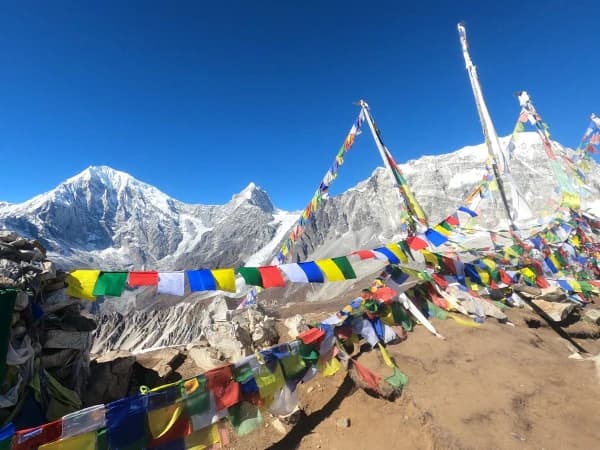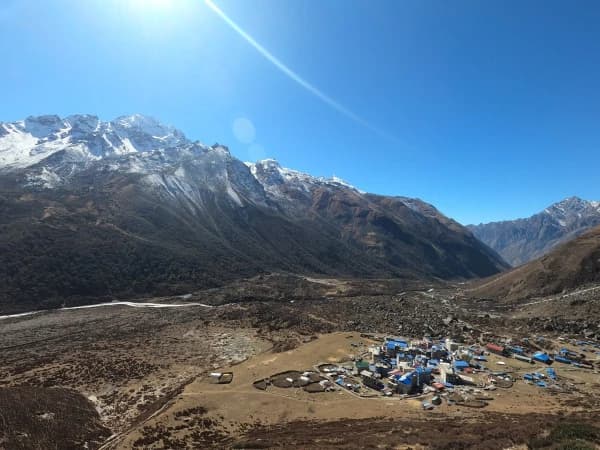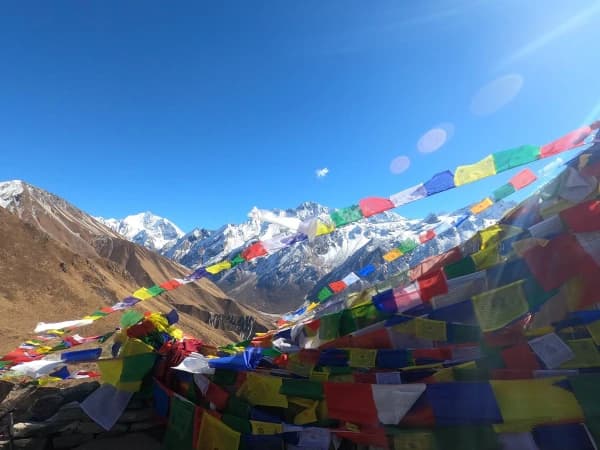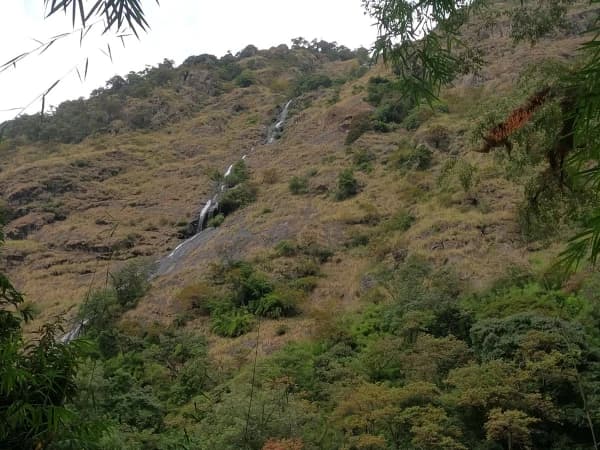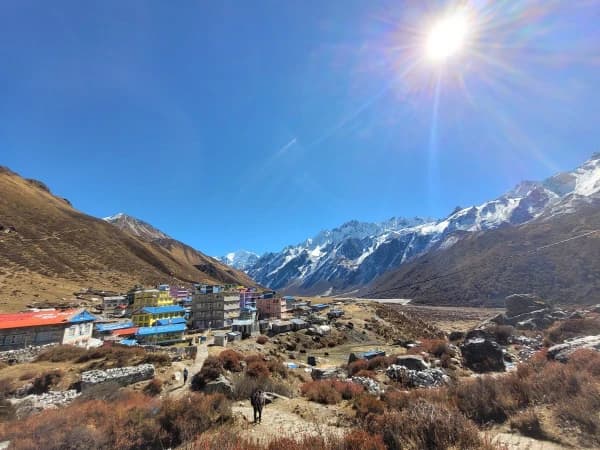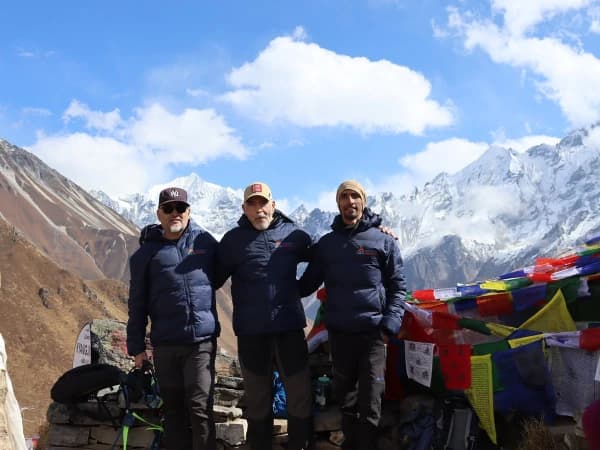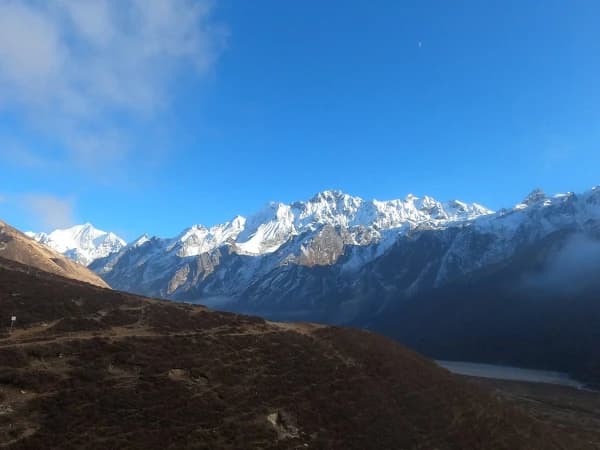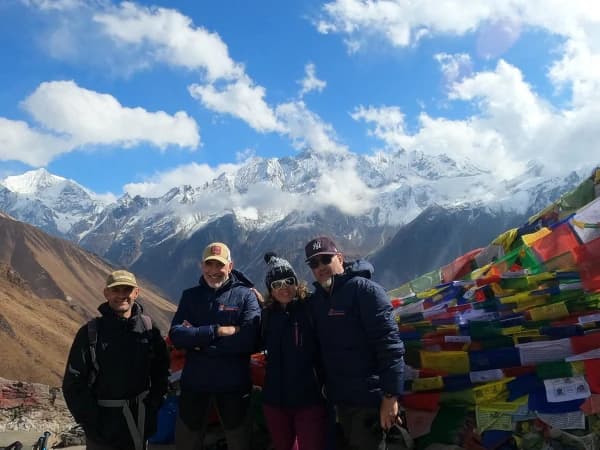The Langtang Valley trek is an unnoticed treasure when it comes to trails in Nepal. With its Indigenous settlements, Buddhist monasteries, cultural monuments, warm hospitality, tranquil trails along the ridges of the valley with the roaring Langtang River below, and at the end of the trek, the majestic Langtang range and the charismatic Kyanjin Gompa village waiting for trekkers, it quickly becomes a favorite. From Kyanjin Gompa, you can do several side treks. The most popular ones are Kyanjin-Ri (4773m) or Cherko-Ri (5000m), with ‘Ri’ standing for ‘mountain’, with viewpoints where you can get amazing panoramic views of the Langtang range.
There is a rich history of the Langtang Valley trek as well: the starting point of the trek, Syaprubesi, is purported to have been established 200 years ago as part of the salt trade route from Tibet to Nepal. The village of Langtang and the valley itself are said to have been discovered by a Buddhist monk chasing his runaway yak sometime in the 15th century, who then built a community there that has now flourished.
While the Langtang Valley trek is not as popular as the Everest Base Camp trek, Annapurna Base Camp trek, or the Annapurna Circuit, this exclusivity means the trails are quieter and there is more time to appreciate nature and the wilderness around you truly. The Langtang Valley trek is a part of the buffer zone of the Langtang National Park, which means you will be near the habitats of charismatic animals like the red panda, black bear, and snow leopard.
The Langtang Valley trek is an easy-to-moderate one, and with plenty of villages and lodges along the way, it is extremely beginner-friendly and often recommended for those who want to get a feel for trekking in Nepal. With ample lodges and a relatively low altitude change along the trail, you can take your time with this trek, which allows you to acclimatize and avoid altitude sickness along the way.
Langtang Valley Trek Highlights
- A majestic and up-close view of Langtang Lirung (7234m) and a glacial lake in the Langtang Himal range, a subrange in the Himalayas
- Trek through Langtang National Park, a habitat for red pandas, Himalayan black bears, langur monkeys, and the elusive snow leopard
- Lodge in peaceful, quaint villages with the Indigenous Tamang and Sherpa people
- A beautiful 300-year-old Buddhist monastery, one of the oldest in Nepal, at Kyanjin Gompa (3840m), the last village on the trail, complete with its yak cheese factory!
- A plethora of side treks to Kyanjin Ri (4773m) or Cherko Ri (5000m), hills that will allow you to see the panoramic view of the Langtang range and a bird’s eye view of the Langtang Valley and Kyanjin Gompa
- An easy to moderate trek that takes you through the heart of the Langtang Valley with the Langtang River roaring along the way and forests of rhododendron, pine, juniper, and bamboo
- Trails with ancient chortens, grazing yaks, and beautiful scenery of rolling hills and mountain peaks on the horizon
- A trek that takes you from the hills of Syaprubesi (1480m) to the alpine village of Kyanjin Gompa, allowing you to see the myriad landscapes and vegetation in Nepal
- The trek through the Langtang Valley, known as the glaciers valley trek
What is it like trekking the Langtang Valley Trek?
Our Langtang Valley Trek spanning 11 days will take you to an incredible range of landscapes, cultures, and terrains Nepal has to offer. From the Himalayas at the end of the trek at Kyanjin-RI, and the mountain vistas from Kyanji-Ri and Cherko-RI. This trek will be an awe-inspiring and life-changing adventure, one which will stay with you for a very long time. The trek starts from Syaprubesi after a 6 to 7-hour drive from Kathmandu. The ride takes you through the hills and mountains of Nepal with verdant landscapes and valleys.
From Syaprubesi, you will begin your trek through iconic villages in the Langtang Valley like Lama Hotel, Langtang, and Kyanjin Gompa. From Kyanjin Gompa, you will have the choice to hike up to Kyanjin-Ri or Cherko-Ri, hills amidst the Langtang range that will allow you to get panoramic views of the Himalayas and bird-eye views of Kyanjin Gompa and the Langtang Valley below. From Kyanjin Gompa, you will make your way to Thulo Syapru and back to Kathmandu.
The trails on this trek are diverse, and you will walk through lush forests of rhododendron, oak, bamboo, and pines, or alpine meadows, depending on the altitude. Most of the trail is protected as it falls under the Langtang National Park Buffer Zone, meaning you will see untouched natural rivers, waterfalls, forests, and grasslands. In the quieter months, you may even come across troops of langur monkeys sunning themselves on large rocks in the rivers.
Langtang Valley trek follows the Langtang River, so the trails are along the ridges of the hills leading to the Langtang range. While there are some stairs and uphills, the trail also has undulating hills, making it a suitable trek for beginners or for those who need some breaks along the way. All along the trail are villages (often in 2-3 hours of walking), so you always have a place to rest if you need to. The highest altitude in the Langtang Valley trek is Cherko-Ri (5000m) with an additional day of acclimatization at Kyanjin Gompa (3800m), so this is ideal for those who are cautious about altitude sickness.
After Langtang Valley, you make your way back to Thulo Syapru, which will be your final stop of the trek. The next day morning you drive back to Kathmandu from Thulo-Syapru, you drive back to Kathmandu for 6-7 hours. In Kathmandu, you are free to explore the city before flying to your next destination, bidding farewell to an epic adventure in the Nepal Langtang Valley trek!
Major attractions of the Langtang Valley Trek
Before you begin your trek, you will have the opportunity to explore Kathmandu, the historic capital city of Nepal. Here you can visit Nepal’s UNESCO World Heritage Sites such as the revered Hindu temple Pashupatinath, significant Buddhist stupas and sites: Swayambhu and Bouddha, and the ancient palace squares with their unique architecture and historical temples.
After Kathmandu, you enter the buffer zone of the Langtang National Park, walking through the Langtang Valley to reach the villages of Langtang and Kyanjin Gompa, where you can see Langtang Lirung (7234m) and the glacial lakes in the Langtang range, part of the larger Himalayan range. The last village on the trail, Kyanjin Gompa, is a fairly well-settled mountain village that offers amazing side trips (either to Kyanjin Ri, Cherko Ri, the 300-year-old Buddhist monastery which is one of the oldest in the country, yak cheese factory, or the Langtang river below) with a friendly community that has welcomed trekkers since the 1960s. Viewpoints Kyanjin Ri and Cherko Ri provide an amazing panoramic view of the Himalayas and the valley below.
Along the trek and from Kyanjin Ri and Cherko Ri, you will see mountain vistas with peaks like Langtang Lirung (7234m), Langtang Ri (7205m), Dorje Lakpa (6966m), among many, many more.
From the Langtang Valley, we take our trail back down to the final destination of the trek, Thulo-Syapru. From here, you drive back to Kathmandu, 6 to 7 hours after this, where you are free to explore the city or kick back and relax after your epic adventure through mountains, forests, and waterfalls.
Who can do the Langtang Valley 8-day trek?
The Langtang Valley trek is known to be an easier alternative to treks in the Annapurna and Everest regions. The trek is recommended for all ages. As long as you have basic fitness and endurance, you will be able to do this trek. Trekkers from around the world are welcome here. This trek can be done as a group or a solo trek as well. Solo trekkers will be accompanied by a guide and a porter. Please note that if you choose to do a group trek, there may be other trekkers joining you as well. The Langtang Valley trek is quite flexible for different types of groups, and we encourage everyone, including students and senior citizens, to join this trek.
Trek Nutshell
- Trekking durations are 7 to 14 days.
- The Trek category is moderate, with some challenging sections.
- Maximum Altitude 4,773 m. (kyanjin-ri) and 4985 m. (Tsergo-ri).
- The best time to visit is spring (March-May) and autumn (September-November).
- Trek's start and end point is Syabrubeshi.
- Trek route Syabrubeshi/lama hotel/langtang village/kyanjing gompa descend same way.
- Required permits: Langtang National Park entry permit and TIMS card.
- Cultural experience of the Tamang community and a visit to an old monastery in the region.
- Home of the wildlife animals, red pandas, Himalayan black bears, and other wildlife.
- Mesmerizing vistas of the Langtang Himalaya range and Ganesh Himal.
- Trek through lush pine and rhododendron forests with diverse vegetation.
- Food and accommodations: local and western cuisine, sleeping in guest houses.
- Safety and Challenges: Risk of altitude sickness.
- Every day, walk around 6 to 7 hours.
- The total trekking distance is 78 to 90 kilometers.
- Trek accessibility is easy to access from Kathmandu by bus or private car/ jeep/ van.
- Ensure travel insurance in case of an emergency.
